| x | 1 | 2 | 3 | 4 | 5 | 6 |
| p(x) | 0.167 | 0.167 | 0.167 | 0.167 | 0.167 | 0.167 |
2 Discrete random variables
A categorical random variable has nominal or ordinal outcomes such as; {red, blue, green} or {tiny, small, average, large, huge}.
A discrete random number is usually counts and has a countable number of outcome values, such as {1,2,3,4,5,6}; {0,2,4,6,8} or all integers.
A discrete or categorical random variable can be described by its probability mass function (PMF).
The probability that the random variable, \(X\), takes the value \(x\) is denoted \(P(X=x) = p(x)\). Note that:
- \(0 \leq p(x) \leq 1\), a probability is always between 0 and 1.
- \(\sum p(x) = 1\), the sum over all possible outcomes is 1.
Example 2.1 (The number of dots on a dice) When rolling a dice the there are six possible outcomes; 1, 2, 3, 4, 5 and 6, each of which have the same probability, if the dice is fair. The outcome of one dice roll can be described by a random variable \(X\). The probability of a particular outcome \(x\) is denoted \(P(X=x)\) or \(p(x)\).
The probability mass function of a fair six-sided dice can be summarized in a table;
or in a barplot;
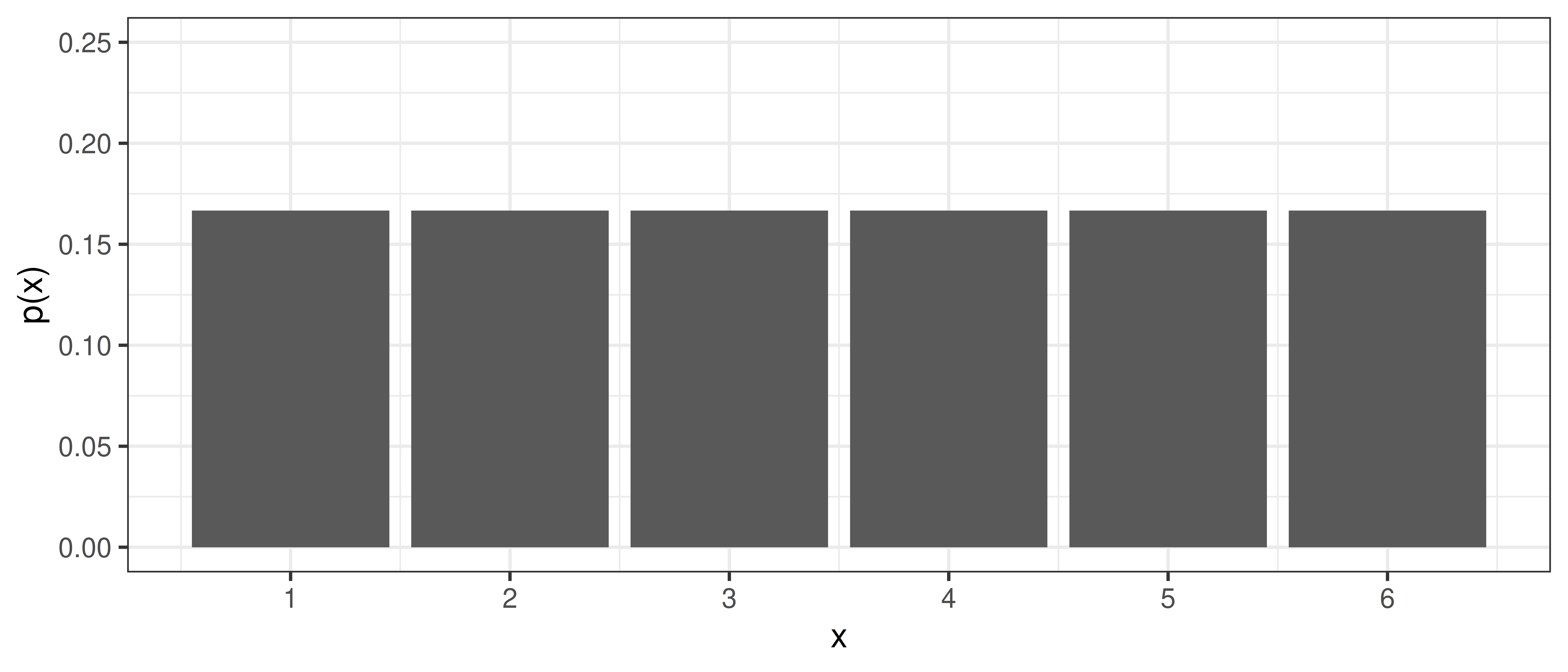
Example 2.2 (Nucleotide in a given site) The nucleotide at a given genomic site can be one of the four nucleotides; {A, C, T, G}. Unlike the sides on a dice the four nucleotides are usually not equally likely. The nucleotide at the site can be described by a random variable, \(X\). The probability mass function can be summarized in a table or a bar plot.
| x | A | C | T | G |
| p(x) | 0.4 | 0.2 | 0.1 | 0.3 |
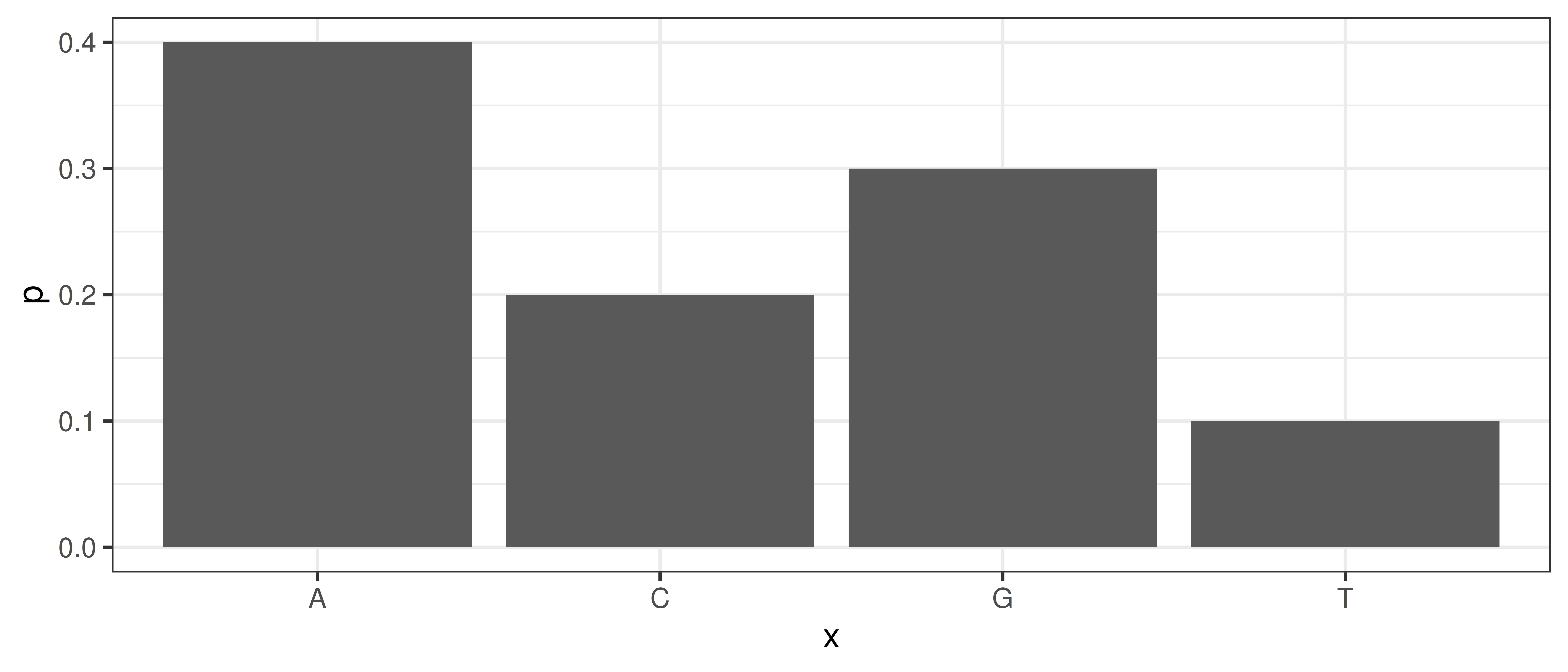
Example 2.3 (CFU) The number of bacterial colony forming units (CFU) on a plate is a random number that can be described by a pmf such as in Figure 2.3.
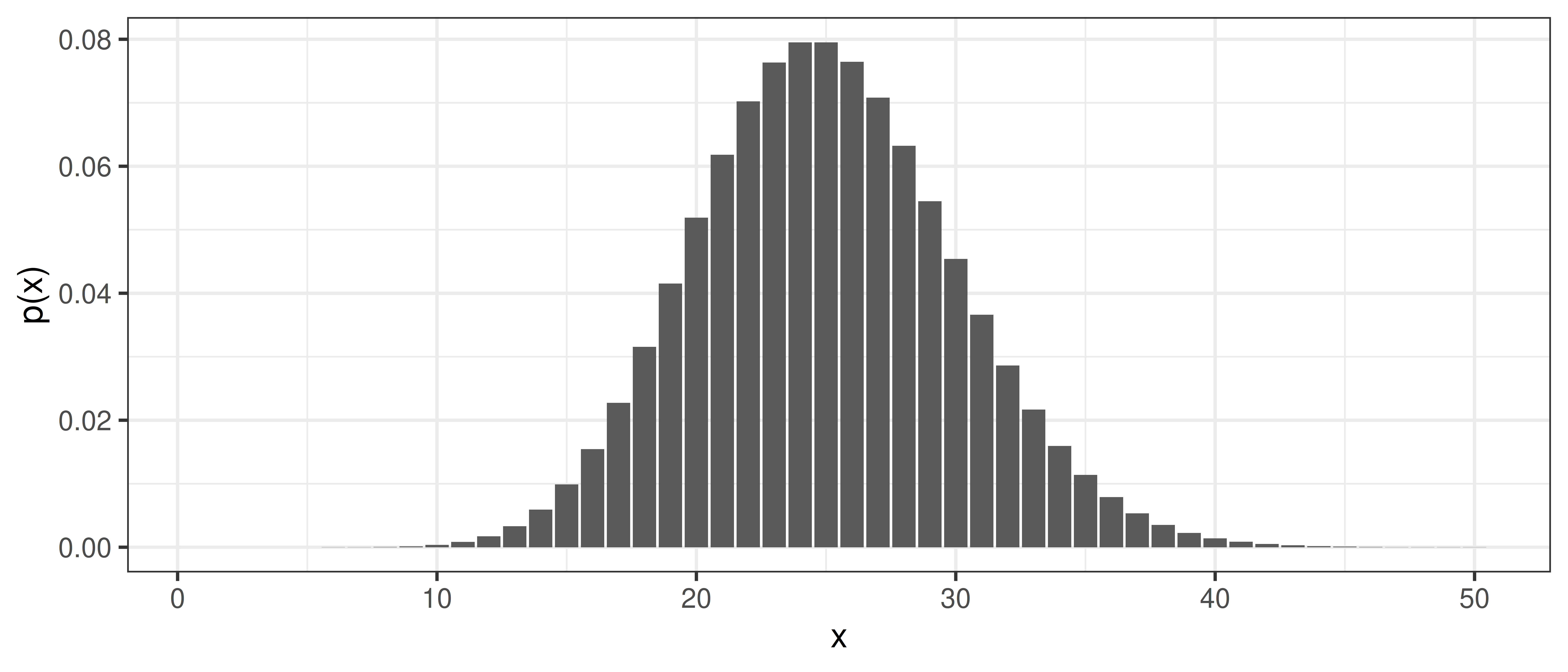
The probability mass function can be used to compute the probability of an event, such as the events
get an even number when rolling a - sum up the probabiliy for 2, 4, and 6, p(even)=p(2)+p(4)+p(6)=0.5
less than 15 CFUs on an agar plate - sum upp the probabilities \(P(X<15) = \sum_{k=0}^{14} p(k) = 0.01\)
The cumulative distribution function (CDF) is defined for numeric discrete random variables as \(F(x) = P(X<=x)\).
2.1 Expected value and variance
Two common properties of a probability distribution, such as a probability mass function, are the expected value and the variance.
The expected value is the average outcome of a random variable over many trials and is denoted \(E[X]\) or \(\mu\) and can be computed by summing up all possible outcome values weighted by their probability;
\[E[X] = \mu = \sum_{i=1}^n x_i p(x_i),\] where \(n\) is the number of outcomes.
For a uniform distribution, where every outcome has the same probability , the expected value can be computed as the sum of all outcome values divided by the total number of outcome values.
The expected value can also be computed as the population mean, i.e. by summing over outcome value for every object in the population (this is of course only possible if the population is countable);
\[E[X] = \mu = \frac{1}{N}\sum_{i=1}^N x_i,\] where \(N\) is the number of objects in the population.
The variance is a measure of spread defined as the expected value of the squared difference of the random variable and its expected value;
\[var(X) = \sigma^2 = E[(X-E[X])^2] = \sum_{i=1}^n (x_i-\mu)^2 p(x_i).\] The variance can also be computed by summing over the outcome value for every object in the population;
\[var(X) = \sigma^2 = \frac{1}{N}\sum_{i=1}^N (x_i-\mu)^2,\] where \(N\) is the number of objects in the population.
The standard deviation is the square root of the variance. The standard deviation of a random variable is usually denoted \(\sigma\). The standard deviation is always positive and on the same scale as the outcome values.
2.1.1 Linear transformations and combinations
\[E(aX) = a E(X)\]
\[E(X + Y) = E(X) + E(Y)\]
\[E[aX + bY] = aE[X] + bE[Y],\] where \(a\) and \(b\) are constants.
\[var(aX) = a^2 var(X)\]
For independent random variables X and Y
\[var(aX + bY) = a^2var(X) + b^2var(Y)\]
2.2 Simulate distributions
Once a random variable’s probability distribution is known, probabilities, such as \(P(X=x), P(X<x)\) and \(P(X \geq x)\), and properties, such as expected value and variance, of the random variable can be computed. If the distribution is not known, simulation might be the solution.
Example 2.4 (Simulate coin toss) In a single coin toss the probabity of heads is 0.5. In 20 coin tosses, what is the probability of at least 15 heads?
The outcome of a single coin toss is a random variable, \(X\), with two possible outcomes \(\{H, T\}\). We know that \(P(X=H) = 0.5\). The random variable of interest is the number of heads in 20 coin tosses, \(Y\). The probability that we need to compute is \(P(Y \geq 15)\).

A single coin toss can be modelled by an urn with two balls. When a ball is drawn randomly from the urn, the probability to get the black ball (heads) is \(P(X=H) = 0.5\).
In R we can simulate random draws from an urn model using the function sample.
## A single coin toss
sample(c("H", "T"), size=1)[1] "H"## Another coin toss
sample(c("H", "T"), size=1)[1] "T"Every time you run sample a new coin toss is simulated.
If we want to simulate tossing 20 coins (or one coin 20 times) we can use the same urn model, if the ball is replaced after each draw.
The argument size tells the function how many balls we want to draw from the urn. To draw 20 balls from the urn, set size=20, remember to replace the ball after each draw!
## 20 independent coin tosses
(coins <- sample(c("H", "T"), size=20, replace=TRUE)) [1] "T" "H" "T" "T" "T" "T" "H" "T" "T" "H" "T" "H" "T" "T" "T" "T" "H" "T" "H"
[20] "H"How many heads did we get in the 20 random draws?
## How many heads?
sum(coins == "H")[1] 7We can repeat this experiment (toss 20 coins and count the number of heads) several times to estimate the distribution of number of heads in 20 coin tosses.
To do the same thing several times we use the function replicate.
To simulate tossing 20 coins and counting the number of heads 10000 times, do the following;
Nheads <- replicate(10000, {
coins <- sample(c("H", "T"), size=20, replace=TRUE)
sum(coins == "H")
})Plot the distribution of the number of heads in a histogram.
hist(Nheads, breaks=0:20-0.5)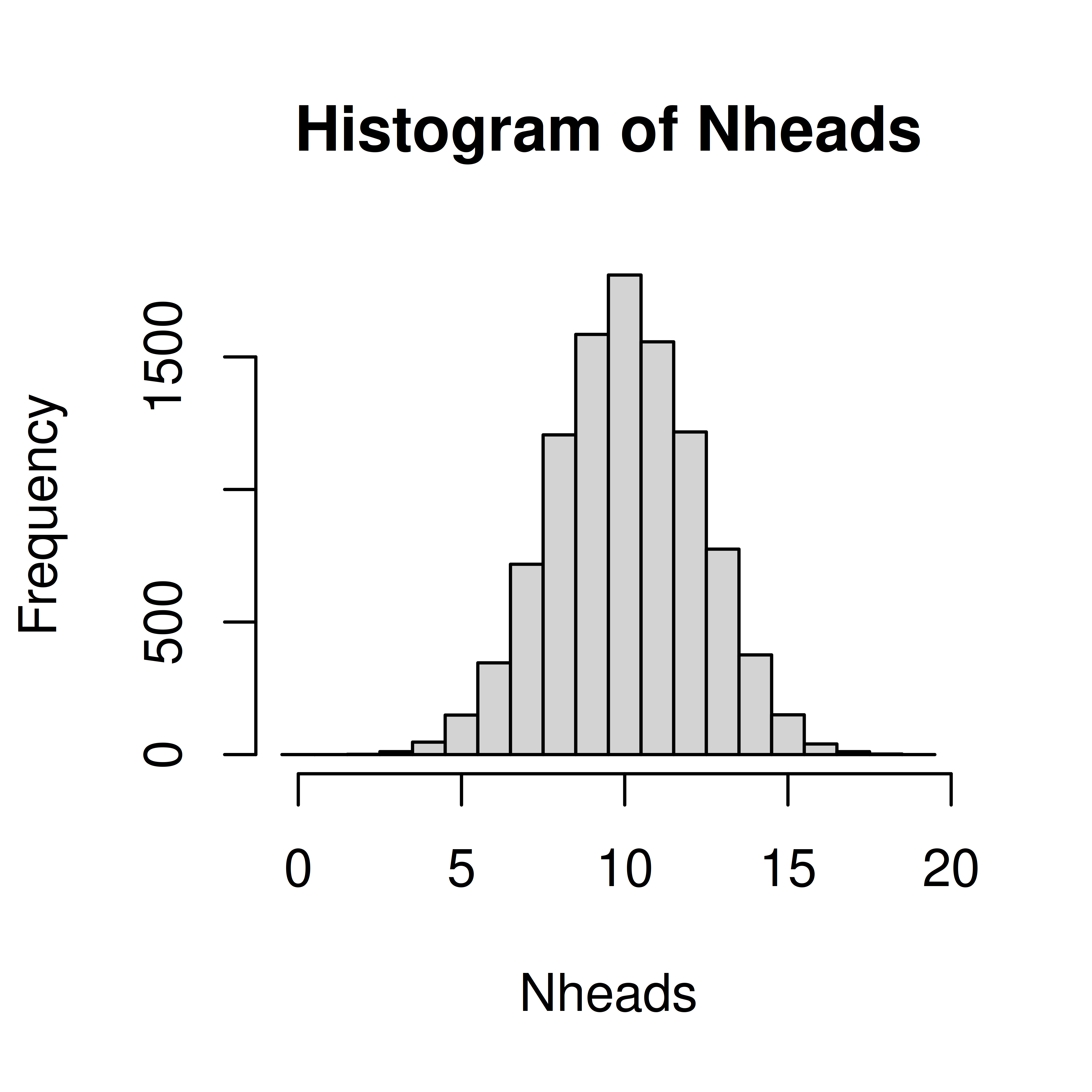
Now, let’s get back to the question; when tossing 20 coins, what is the probability of at least 15 heads?
\(P(Y \geq 15)\)
Count how many times out of our 10000 experiments the number is 15 or greater
sum(Nheads >= 15)[1] 190From this we conclude that
\(P(Y \geq 15) =\) 190/10000 = 0.0190
Resampling can also be used to compute other properties of a random variable, such as the expected value.
The law of large numbers states that if the same experiment is performed many times the average of the result will be close to the expected value.
The coin flip is a common example in statistics, but many situations with two outcomes can be modeled using similar models. If we consider the outcome of interest succes (like heads in the coin example) and the alternative outcome failure we can for example model;
- Drug effect: A patient can respond to drug treatment (success) or not (failure)
- Side effect: After a treatment a patient might experience a side effect (success) or not (failure)
- Treatment or placebo: Randomly assign a study participant into treatment or placebo group
- Antibiotic resistance: A bacteria is either resistant to an antibiotic or not
The probability of success and failure can be equal, like in the coin example, but they don’t have to be equal. If the probability of a patient responding to a treatment is \(p=0.80\), we know that the probability of the patient not responding is \(1-p=0.20\), this can be modelled using an urn model with 4 black balls (cured) and 1 white ball (not cured).
2.3 Parametric discrete distributions
A discrete parametric distribution is a probability distribution described by a set of parameters. In many situations data can be assumed to follow a parametric distribution.
2.3.1 Uniform
In a uniform distribution every possible outcome has the same probability. With \(n\) different outcomes, the probability for each outcome is \(1/n\).
2.3.2 Bernoulli
A Bernoulli trial is a random experiment with two outcomes; success and failure. The probability of success, \(P(success) = p\), is constant. The probability of failure is \(P(failure) = 1-p\).
When coding it is convenient to code success as 1 and failure as 0.
The outcome of a Bernoulli trial is a discrete random variable, \(X\).
\[P(X=x) = p(x) = \left\{ \begin{array}{ll} p & \mathrm{if}\,x=1\mathrm,\,success\\ 1-p & \mathrm{if}\,x=0\mathrm,\,failure \end{array} \right.\]
Using the definitions of expected value and variance it can be shown that;
\[E[X] = p\] \[var(X) = p(1-p)\]
A Bernoulli trial can be simulated, as seen in previous section, using the function sample.
2.3.3 Binomial
The number of successes in a series of independent and identical Bernoulli trials is a binomial random variable, \(X\).
\(X = \sum_{i=0}^n Z_i,\)
where all \(Z_i\) describe the outcome of independent and identical Bernoulli trials with probability \(p\) for success (\(P(Z_i=1) = p\)).
The probability mass function of \(X\) is called the binomial distribution. In short we use the notation;
\[X \sim Bin(n, p)\]
The probability mass function is
\[P(X=k) = \binom{n}{k} p^k (1-p)^{n-k}\] It can be shown that
\[E[X] = np\] \[var(X) = np(1-p)\]
A binomial random variable is the number of successes when sampling \(n\) objects with replacement from an urn with objects of two types, of which the interesting type (success) has probability \(p\).
The probability mass function, \(P(X=k)\) can be computed using the R function dbinom and the cumulative distribution function \(P(X \leq k)\) can be computed using pbinom.
Examples fo binomial random variables;
- The number of patients responding to a treatment out of \(n\) patients in a study, if the probability of a patient responding to treatment is \(p\).
- The number of patients experiencing a side effect out of \(n\) patients in a study, if the probability of a side effect is \(p\).
- the number of mutations in a gene of length \(n\), if the mutations are independent and identically distributed and the probability of a mutation at every single position is \(p\).
2.3.4 Poisson
The Poisson distribution describe the number of times a rare event occurs in a large number of trials. Commonly used to describe the number of events during a given time period.
A rare disease has a very low probability for a single individual. The number of individuals in a large population that catch the disease in a certain time period can be modelled using the Poisson distribution.
The probability mass function has a single parameter, \(\lambda\), the expected value, and can be described as;
\[P(X=k) = \frac{\lambda^k}{k!}e^{-\lambda}\]
The expected value \(\lambda = n \pi\), where \(n\) is the number of objects sampled from the population and \(\pi\) is the probability of a single object.
The variance is equal to the expected value;
\[var(X) = E[X] = \lambda = n \pi\]
The Poisson distribution can approximate the binomial distribution if \(n\) is large (\(n>20\)) and \(\pi\) is small (\(\pi<0.05\) and \(n\pi < 10\)).
Examples of Poisson random variables;
- A rare disease has a very low probability for a single individual. The number of individuals in a large population that catch the disease in a certain time period is a Poisson random variable.
- Number of reads aligned to a gene region
2.3.5 Negative binomial
A negative binomial distribution describes the number of failures that occur before a specified number of successes (\(r\)) has occurred, in a sequence of independent and identically distributed Bernoilli trials. \(r\) is also called the dispersion parameter.
In R: dnbinm, pnbinom, qnbinom
2.3.6 Geometric
The geometric distribution is a special case of the negative binomial distribution, where \(r=1\).
In R: dgeom, pgeom, qgeom
2.3.7 Hypergeometric distribution
The hypergeometric distribution occurs when sampling \(n\) objects without replacement from an urn with \(N\) objects of two types, of which the interesting type has probability \(p\).
The probability mass function
\[P(X=k) = \frac{\binom{Np}{k}\binom{N-Np}{n-k}}{\binom{N}{n}}\] can be computed in R using dhyper and the cumulative distribution function \(P(X \leq k)\) can be computed using phyper.
Examples of hypergeometric random variables;
- In a student group of 25 individuals, 10 are R beginners. If 5 individuals are randomly choosen to belong to group A, the number of R beginners in group A is a hypergeometric random variable.
- A drug company is producing 1000 pills per day, 5% have an amount of active substance below an acceptable threshold. In a random sample of 10 pills, how many contain to little active substance? The number of pills with to little active substance is a hypergeometric random variable.
- You investigate the differential expression of 10000 genes, 150 of these genes belong to the super interesting pathway XXX. You run a black-box algorithm that report 80 differentially expressed (DE) genes. If the black-box algorithm choose DE genes at random, the number of DE genes that belong to pathway XXX is a hypergeometric random variable.
2.3.8 Summary of discrete distributions
The binomial, hypoergeometric, negative binomial and poisson distributions have similarities. For large N (large population) the hypergeometric and binomial distributions are very similar. The Poisson distribution has equal variance and mean, whereas the binomial has a variance less than the mean and the negative binomial has a variance greater than the mean.
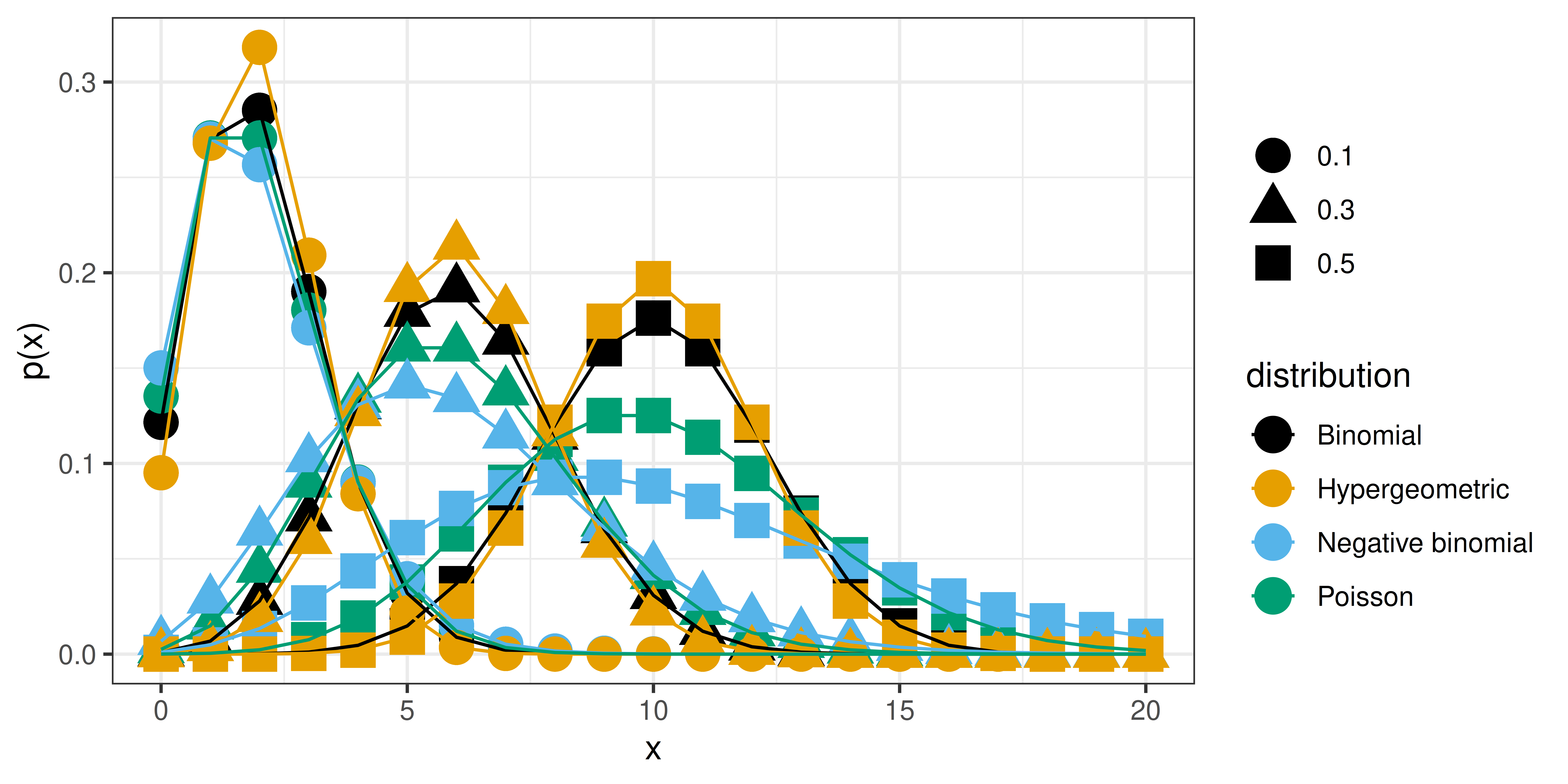
Probability mass functions, \(P(X=x)\), for the binomial, hypergeometric, negative binomial and Poisson distributions can in R can be computed using functions dbinom, dhyper, dnbinom and dpois, respectively.
Cumulative distribution functions, \(P(X \leq x)\) can be computed using pbinom, phyper, pnbinom and ppois.
Also, functions for computing an \(x\) such that \(P(X \leq x) = q\), where \(q\) is a probability of interest are available using qbinom, qhyper, qnbinom and qpois.